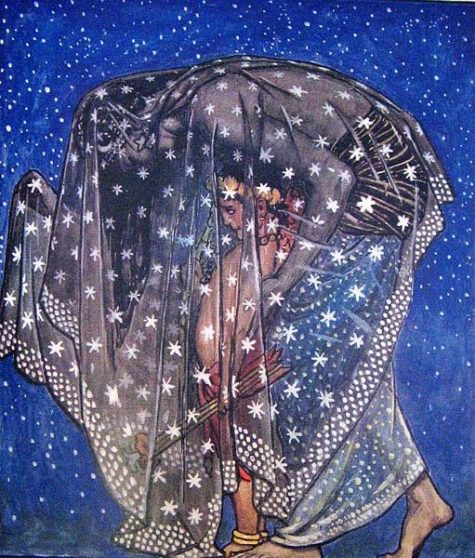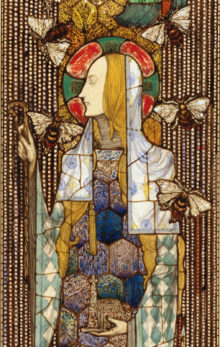Bees
- Names: Nit
- Attributes: Two arrows and a shield, shuttle
- Creatures: Crocodile, snake, bee
- Color: Green
- Plants: Flax, papyrus
- Favored people: Soldiers, hunters, weavers, artisans
The inscription on Neith’s temple in Sais in the Nile Delta (now modern Sa el-Hagar) read:
I am all that has been,
that is and that will be
No mortal has yet been able
to lift the veil that covers me.
Neith, the First One, the primordial goddess, was never born but always existed. Alternatively she is completely self-generated. Neith traveled from the deserts and oases of Libya to emerge as among the greatest of Egyptian goddesses. In one Egyptian creation myth, Neith brought forth Ra, the sun. Then she invented the shuttle and loom, put the sky on her loom, and wove the world into existence. Neith, the first to give birth, invented weaving. Her name may derive from a word for “to weave” or “to knit.”
She is called:
- The Oldest One
- Nurse of Crocodiles
- The Huntress
- Opener of the Ways
- Great Goddess
- Lady of the West
Mother of the Gods, goddess of war and the hunt, she is goddess of the lower heavens, a warrior goddess and protectress. Her name means “I have come from myself,” or self-begotten.
Eternal goddess, universal mother; the Spirit behind the Veil of Mysteries; World Body; Primal Abyss. Her cult was a very ancient one with two queens of the First Dynasty named after her. Often shown along side Selqet as mummy guardian and protectress of marriage. She wore the red crown of Lower Egypt. In her hands she held a bow and two arrows.
Neith is a goddess of hunting. She presides over crafts of all kinds, including witchcraft and warcraft. Amuletic weapons placed in the tomb to protect the deceased from evil spirits were consecrated to Neith. She is the judge of the Egyptian deities. After eighty years, when the lawsuit between Horus and Set in the Court of Deities was still not resolved, Neith was called in to render a decision to which all could defer. (She favored Horus but compensated Set. Neith has historically had a close positive relationship with Set.)
Her ceremonies were of a mystic nature. Neith was worshiped with Mysteries and lantern processions. In December (on or around December 8th), a great festival, called the Feast of Lamps, was held annually in her honor and, according to Herodotus, her devotees burned a multitude of lights in the open air all night during the celebration.
She is the patroness of domestic arts, weaving, hunting, medicine, war, and weapons. Turn to her when working with herbs, magick, healing, mystical knowledge, rituals, and meditation. She is the protectress of women and marriage.
She may be venerated independently or together with her son, Sobek. The Greeks identified her with Athena, also identified as originating in Libya. Many consider Athena to be a Greek path of Neith or at least a very closely related spirit.
Neith appears as an androgynous woman. She wears the red crown of Lower Egypt. She sometimes appears in the guise of a golden cobra, as well. In Iconography, she is customarily depicted with a green face and hands. Neith is portrayed suckling a crocodile at each breast.
The main imagery of Neith was as the deity of the unseen and limitless sky, as opposed to Nut and Hathor, who respectively represented the manifested night and day skies. Her epithet as the “Opener of the Sun’s Paths in all her stations” refers to how the sun is reborn (due to seasonal changes) at various points in the sky, under her control of all beyond the visible world, of which only a glimpse is revealed prior to dawn and after sunset.
It is at these changing points that Neith reigns as a form of sky goddess, where the sun rises and sets daily, or at its ‘first appearance’ to the sky above and below. It is at these points, beyond the sky that is seen, that her true power as the deity who creates life is manifested.
This ancient goddess represents the full ecliptic circle around the sky (above and below). It was this realm, the cosmos below the horizon, that Neith personified, for she is the complete sky which surrounds the upper and lower sky, and which exists beyond the horizon, and thereby beyond the skies themselves. Neith, then, is that portion of the cosmos which is not seen, and in which the sun is reborn daily, below the horizon which may reflect the statement assigned to Neith as “I come at dawn and at sunset daily.”
As the goddess of creation and weaving, she was said to reweave the world on her loom daily. An interior wall of the temple at Esna records an account of creation in which Neith brings forth from the primeval waters of the Nun the first land. All that she conceived in her heart comes into being, including the thirty deities. Having no known husband she has been described as “Virgin Mother Goddess.”
Unique Goddess, mysterious and great who came to be in the beginning and caused everything to come to be . . . the divine mother of Ra, who shines on the horizon…
Sources:
- Other Names: Abigail, Deborah, Mo Gobnat, Gobhnet, Gobnaid, Gobnata, Gobnatae
- Feast Day: February 11
- Patron of Honeybees and Beekeepers
Gobnait is Irish for Abigail which means “Brings Joy”. As the patron saint of beekeepers, her name also has been anglicized as Deborah, meaning “Honey Bee.” This Irish saint is a version of the deity Domna, patroness of sacred stones and cairns. The center of her worship was at Ballybourney, Co. Cork, Ireland.
Her feast day, February 11 is called “Pattern Day” in the parishes of Dún Chaoin and in Baile Bhúirne, and is regarded as both holiday and holy day. In one tradition, a medieval wooden carving of Gobnait, about two feet high, kept in a church drawer during the year, is brought out. Parishioners bring a ribbon to ”measure” the statue. This ribbon is then taken home to use when special blessings are needed.
About Saint Gobnait:
Gobnait was born in County Clare in the 5th or 6th Century, and is said to have been the sister of Saint Abban. Tradition holds that Gobnait fled Clare in order to escape family feuding, settling on Inis Oírr (where there is an early medieval oratory, Cill Ghobnait, dedicated to her). Gobnait was said to have been the only woman allowed on the island, but she didn’t linger. After a time, an angel appeared and told her that she was meant to spend the rest of her days (until her soul left her earthly body) elsewhere. She would know the right place because she would find nine white deer grazing there. So she left the island to journey through the southern coastal counties in search of the deer.
As a result of her quest, a number of places now bear her name – for instance, Kilgobnet or Cill Ghobnait in County Kerry and St Debora’s Well in County Limerick. She eventually came upon that mystical herd in Ballyvourney, County Cork, where she dedicated the remainder of her earthly life to pastoral work.
Her connection to honey bees is complex, beginning with the angel telling her to find her “resurrection place” (meaning where the soul leaves the body). Celtic lore held bees in high esteem believing the soul left the body as a bee or a butterfly.
Bees were more than just honey-makers to the ancient Irish. They have long held an important place in Irish culture. The honey, wax, pollen and other benefits of bees were considered so important that in the 7th century, someone scribed the ancient laws called the Bechbretha, which translates to ‘bee-judgements.’ These laws included six different terms in Gaeilge for the kinds of bee swarms, the proper ways to decide ownership of a swarm of bees, how to punish the theft of hives or honey, as well has how much honey a beekeeper should offer their neighbors, and the Caithchi Bech, the trespassing of bees.
Honey is also well-known for its curative properties, and Gobnait was renowned for her care of the sick. Gobnait added beekeeping to her life’s work developing a lifelong affinity with them. She started a religious order and dedicated her days to helping the sick, probably using honey as a healing aid in the treatment of illness and healing of wounds.. St Gobnait had a particular skill in caring for the sick and she is credited with saving the people at Ballyvourney from the plague.
While her focus was on pastoral work such as tending her hives, healing the sick, and founding a religious community for women, Saint Gobnait was not just a placid nun, oh no. Excavations of her home have found that she was also a metal worker, smithing and smelting.
In the ruins of her church there is a smooth round iron ball set into the wall, known as St. Gobnait’s Bowl. It is said to have been used to destroy a fort built by a pagan chief on the hills north of Ballyvourney and was said to have returned to the Saint each time she threw it. Those who have grasped the bowl in the wall will know the miraculous nature of this feat.
There are also legends of her setting swarms of bees on forces attempting to invade Balleyvourney, causing the swollen and stung invaders to return the cattle they stole before they fled. Some accounts go even further, with the bees miraculously changing into soldiers and their hives transformed into bronze helmets.
‘Tháinig na saighdúirí Gallda agus tógadar mórán stuic i mBaile Mhuirne, ach ar an slige dhóibh ag imeacht an bóthar soir do scaoil Naomh Gobnait na beacha as an mbeachaire. Tosnuigeadar ar na saighdúirí a chealg chun nar fágadar súil ná srón ionnta agus b’éigin dóibh an stuic fhágaint ’na ndiadh’.
The English soldiers came and took a lot of stock in Ballyvourney, but on their way out the east road, Saint Gobnait released the bees from the bee-hive. They started to sting the soldiers until they were left without an eye or a nose and they were forced to leave the stuff behind them.
(from The Bee, its Keeper and Produce, in Irish and other Folk Traditions)
Collected from various sources and compiled by Shirley Twofeathers for The Powers That Be, you may repost and share without karmic repercussions, but only if you give me credit and a link back to this website. Blessed be.





